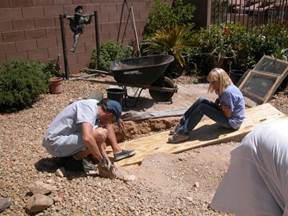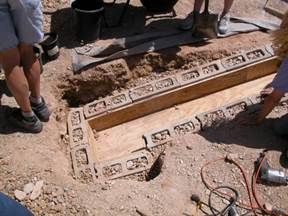Underground Burrow
- Dig a wedge 6′ long and 34″ – 36″ wide. Dig one end 24″ deep, sloping up to ground level (Figure 1).
- Place a 4-mil plastic sheet flat on bottom of hole.
- Cut plywood to size and place the in the hole, with the turnaround at the deep end.
- Fold the plastic over the edges of the plywood, and trim to leave the channel free of plastic.
- Place blocks on plywood (and plastic) in the pattern shown (Figure 2).
- Line the blocks with plywood. Fasten with screws DO NOT USE GLUE. Be sure the wood is tight and does not have a spot for a tortoise nail to get hooked.
- Add boards to narrow the channel, if needed.
- Fill the blocks with dirt.
- Add filtered dirt to channel bottom to create correct height in channel.
- Place 11/2″ Styrofoam layer on top of blocks (to add height for growth) if needed.
- Place a second sheet of plywood over the channel (Figure 3).
- DO NOT ADD A SHEET OF PLASTIC – it creates a greenhouse effect.
- Fill with dirt, packing down somewhat as you go.
- Mound dirt so that it covers the seams created when digging.
- Smooth the top. Mist lightly with water (Figure 4).




